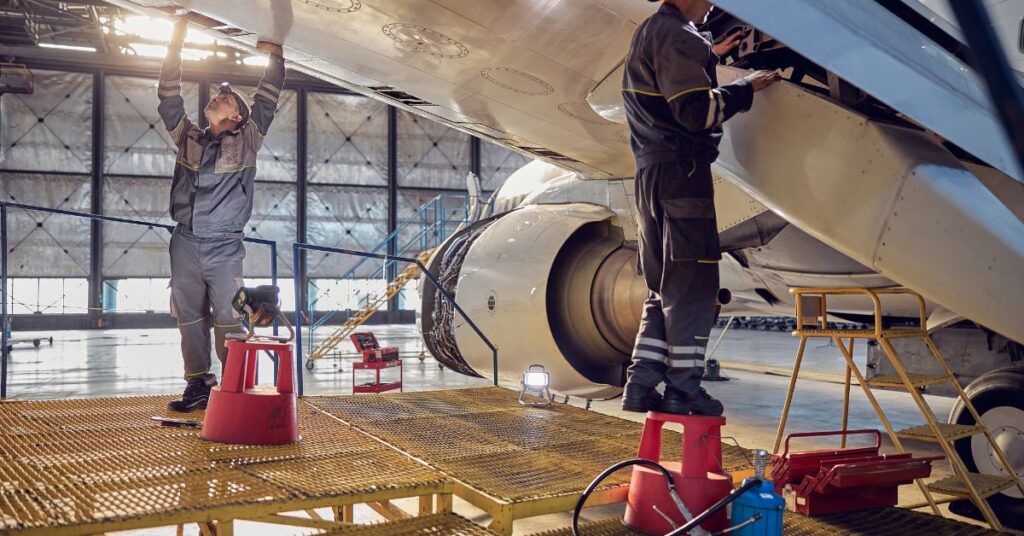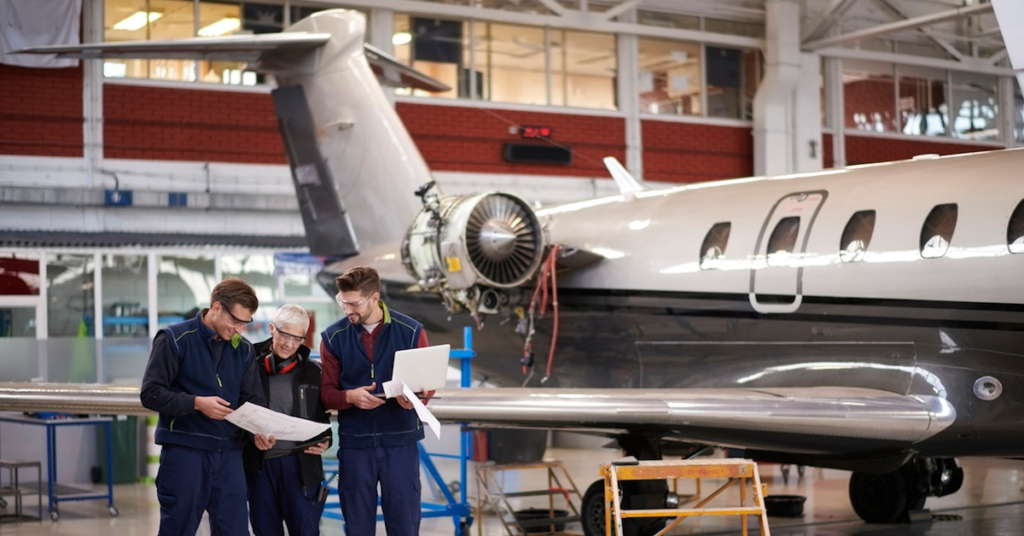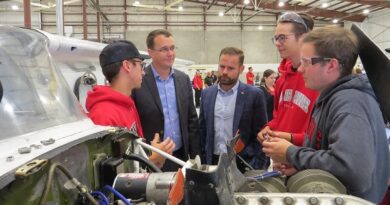|
You need to know and understand how to: SB11. seek clarification on
problems from others SB12. apply problem-solving approaches in different situations SB13. refer anomalies to the line manager.
Analytical Skills
You need to know and understand how to:
SB14. analyze data and activities
SB15. configure data and disseminate relevant information to others
SB16. pass on relevant information to others
Critical Thinking Skills
You need to know and understand how to:
SB17. provide opinions on work in a detailed and constructive way
SB18. apply balanced judgments to different situations
Attention to Detail
You need to know and understand how to:
SB19. check your work is complete and free from errors
SB20. get your work checked by others
Team Working
You need to know and understand how to:
SB21. work independently and collaboratively
SB22. work effectively in a team environment
SB23. contribute to the quality of team working
Technical Skills of Design Engineer Avionics/Electrical systems:
SC1. use information technology effectively to input and/or extract data accurately
SC2. identify and refer anomalies in data
SC3. store and retrieve information
SC4. keep data secure
SC5. agree objectives and work requirements
SC6. use coding standards
SC7. keep up to date with changes, procedures and practices in your role

Create, maintain and design avionics systems.
Performance Criteria of Design Engineer Avionics/Electrical systems:
Create, maintain and design avionics/ electrical Systems
PC1. perform conceptual and detailed avionics system design and analysis
as required for variety of airborne platforms with inputs from ARP 5761 and ARP 4754.
PC2. develop functional algorithms for avionics systems/LRUs and allied systems
PC3. develop PVI/MMI specifications and associated logics
PC4. perform modelling & simulation studies and analysis
PC5. source/realize the avionics LRUs/development environment/testing environment
PC6. perform software development and software engineering process as per DO
178C for development of avionics systems/on-board computers & ground integration rigs / test equipment
PC7. perform hardware development and hardware engineering process as
per DO 254 as applicable for Complex electronics only for development of
avionics systems/on-board computers & ground integration rigs / test equipment
PC8. perform software-software integration, hardware-software integration,
static/dynamic testing, simulator testing, and hardware-in-loop system testing.
PC9. perform system Integration of Avionics System on rig/simulator/aircraft
PC10. perform System Qualification as per DO 160G
PC11. take up technology development/futuristic projects
Knowledge and Understanding
Organizational Context
KA1. organization’s objective, vision, diversified segments, products etc
KA2. regulatory compliance with respect to modification and changes
KA3. organization’s requirement for IP protection
KA4. hazard and risk management as defined by organisation
KA5. compliance requirement for the roles and responsibility
KA6. organization’s safety and security requirements
Technical Knowledge
KB1. aerospace electrical manufacturing and avionics software testing process
KB2. appropriate avionics/electrical techniques and solutions for aerospace applications
KB3. full-lifecycle analogue and digital circuit design
KB4. technical regulations pertaining to aircraft certification
KB5. Industrial certification standards and calibration of avionics components
KB6. aerospace design and theory of flight
KB7. necessary data to produce the required drawings:
drawing brief/request
specifications
change order/modification request
aircraft electrical/electronic regulations
manuals
previous drawings/designs
calculations (such as Ohm’s Law)
sketches
standards reference documents (such as current carrying
capacity of cables, electronic component catalogues)
notes from meetings/discussions
other specific data
KB8. the following design features, in relation to the drawing being produced:
physical dimensions of the circuit
types of component to be used
aesthetics
operating environment
component orientation
interfaces
position of circuit elements/components
special labels (such as orientation reference points)
safety
power supplies
lifetime of the product
· connections between components
· tolerances
· appropriate type of circuit (such as digital, analogue, hybrid)
· appropriate technology of circuit design (such as single sided, double sided, multi-layer, flexi-rigid)
meets signal integrity parameters (such as capacitance, inductance, resistance, insulation voltages)
meets specified operating conditions (such as temperature, humidity, shock and vibration)
any assembly/manufacturing schedule constraints (such as high profile components
mounted after surface mount technology (SMT) ones)
KB9. the following before producing the engineering drawing:
ensure that data and information are complete and accurate
review the data and information to identify the drawing requirements
recognise and deal with problems (information based and technical)
KB10. technique to produce electronic engineering drawings for the
following aircraft electrical/avionics systems:
electrical power generation and distribution
armament equipment and systems
lighting (internal or external)
passive warning and electronic countermeasure systems
indication and gauging
infra-red and optical systems
pitot static
radar systems
communication
flight guidance and control systems
navigational
other specific electronic circuit
KB11. technique to produce the following types of
electronic engineering drawings:
circuit diagrams
circuit board assembly
wiring diagrams
circuit board layout
block diagrams
general assembly drawings
schematics
manufacture of cable looms
system drawings
fault diagnostics (such as flow diagrams)
modifications to electronic equipment/systems
(such as circuit board layout, cable looms, cable routeing and clipping, panels/
sub-assemblies, installation of electronic systems)
KB12. technique to produce electronic engineering drawings which include:
straight lines
curved/contour lines
dimensions
ci rcles or ellipses
· angled lines
· parts lists
· text
· test points
· insertion of electronic components
· colour/component coding
· type and size of cables
fault diagnosis (such as flow diagrams)
connection/termination details
electrical/electronic symbols and abbreviations
other specific electronic detail
Core Skills/ Generic Skills of Design Engineer Avionics/Electrical systems:
Writing Skills
The user/individual on the job needs to know and understand how to:
SA1. complete accurate technical documents , well written work with attention to detail
Reading Skills
The user/individual on the job needs to know and understand how to:
SA2. read instructions/guidelines/procedures/rules
Oral Communication (Listening and Speaking skills)
The user/individual on the job needs to know and understand how to:
SA3. listen to and orally communicate information with all concerned
Professional Skills
Making
The user/individual on the job needs to know and understand how to:
SB1. make decisions on a suitable course of action or response if permitted by the authority matrix
Plan and Organise
The user/individual on the job needs to know and understand how to: SB2. monitor efficient functioning of all activities
SB3. plan and organise work to achieve targets and deadlines
Customer Centricity
The user/individual on the job needs to know and understand how to: SB4. communicate with customers and other stakeholders in a courteous manner
SB5. maintain cordial work relationship
Problem Solving
The user/individual on the job needs to know and understand how to:
SB6. identify trends/common causes for errors and suggest possible solutions to the supervisor/management
SB7. identify and correct errors
Analytical Skills
The user/individual on the job needs to know and understand how to:
SB8. analyse best possible solutions (cost, time, effort, etc.) suited for operations
Critical Thinking Skills
The user/individual on the job needs to know and understand how to:
SB9. concentrate on task at hand and complete it without errors
SB10. apply balanced judgments to different situations
 Create, maintain and design electrical systems Create, maintain and design electrical systems
Performance Criteria of Design Engineer Avionics/Electrical systems:
Create, maintain and design electrical Systems
PC1. perform conceptual and detailed electrical system design and analysis as required for variety of airborne platforms
PC2. design power conversion system, circuit designs and power systems design
PC3. develop circuit and wiring diagrams, block diagrams, schematics,
electrical cabling/routing, installation, assembly of panels and sub-assemblies and system design/modification
PC4. select the appropriate equipment and drawing software to use, based
on the type and complexity of the drawing functions to be carried out
PC5. use current British, European, International and company standards to produce a
drawing template for a range of paper sizes, and include the drawing title, scale used, date of drawing and other relevant information
PC6. produce fully detailed drawings, to enable the electrical circuits to be assembled, installed, maintained, commissioned or modified
Knowledge and Understanding
Organisational Context
The user/individual on the job needs to know and understand:
KA1. organisation’s objective, vision, diversified segments, products etc
KA2. regulatory compliance with respect to modification and changes
KA3. organisation’s requirement for IP protection
KA4. hazard and risk management as defined by organisation
KA5. compliance requirement for the roles and responsibility
KA6. organisation’s safety and security requirements
Technical Knowledge
KB13. aerospace electrical manufacturing
KB14. appropriate electrical techniques and solutions for aerospace applications
KB15. full-lifecycle analogue and digital circuit design
KB16. technical regulations pertaining to aircraft certification
KB17. Industrial certification standards and calibration of electrical components
KB18. aerospace design and theory of flight
KB19. necessary data to produce the required drawings:
drawing brief/request
specifications
change order/modification request
aircraft electrical/electronic regulations
manuals
previous drawings/designs
calculations (such as Ohm’s Law)
sketches
standards reference documents (such as current carrying capacity of cables, electronic component catalogues)
notes from meetings/discussions
other specific data
KB20. the following design features, in relation to the drawing being produced:
physical dimensions of the circuit
types of component to be used
aesthetics
operating environment
component orientation
interfaces
position of circuit elements/components
special labels (such as orientation reference points)
safety
power supplies
function
· lifetime of the product
· connections between components
· tolerances
· appropriate type of circuit (such as digital, analogue, hybrid)
appropriate technology of circuit design (such as single sided, double sided, multi-layer, flexi-rigid)
meets signal integrity parameters (such as capacitance, inductance, resistance, insulation voltages)
meets specified operating conditions (such as temperature, humidity, shock and vibration)
any assembly/manufacturing schedule constraints (such as high profile
components mounted after surface mount technology (SMT) ones)
KB21. the following before producing the engineering drawing:
ensure that data and information are complete and accurate
review the data and information to identify the drawing requirements
recognise and deal with problems (information based and technical)
KB22. technique to produce electrical engineering drawings for the following aircraft electrical systems:
electrical power generation and distribution
armament equipment and systems
lighting (internal or external)
passive warning and electronic countermeasure systems
indication and gauging
infra-red and optical systems
pitot static
radar systems
communication
flight guidance and control systems
navigational
other specific electronic circuit
KB23. technique to produce the following types of electronic engineering drawings:
circuit diagrams
circuit board assembly
wiring diagrams
circuit board layout
block diagrams
general assembly drawings
schematics
manufacture of cable looms
system drawings
fault diagnostics (such as flow diagrams)
modifications to electronic equipment/systems
(such as circuit board layout, cable looms, cable routeing and clipping, panels/sub-assemblies, installation of electronic systems)
KB24. technique to produce electronic engineering drawings which include:
straight lines
curved/contour lines
dimensions
· circles or ellipses
· angled lines
· parts lists
· text
· test points
· insertion of electronic components
colour/component coding
type and size of cables
fault diagnosis (such as flow diagrams)
connection/termination details
electrical/electronic symbols and abbreviations< br> other specific electronic detail
Core Skills/ Generic Skills of Design Engineer Avionics/Electrical systems:
Writing Skills
The user/individual on the job needs to know and understand how to:
SA1. complete accurate technical documents , well written work with attention to detail
Reading Skills
The user/individual on the job needs to know and understand how to:
SA2. read instructions/guidelines/procedures/rules
Oral Communication (Listening and Speaking skills)
The user/individual on the job needs to know and understand how to:
SA3. listen to and orally communicate information with all concerned
Professional Skills
Making
The user/individual on the job needs to know and understand how to:
SB1. make decisions on a suitable course of action or response if permitted by the authority matrix
Plan and Organise
The user/individual on the job needs to know and understand how to: SB2. monitor efficient functioning of all activities
SB3. plan and organise work to achieve targets and deadlines
Customer Centricity
The user/individual on the job needs to know and understand how to: SB4. communicate with customers and other stakeholders in a courteous manner
SB5. maintain cordial work relationship
Problem Solving
The user/individual on the job needs to know and understand how to:
SB6. identify trends/common causes for errors and suggest possible solutions to the supervisor/management
SB7. identify and correct errors
Analytical Skills
The user/individual on the job needs to know and understand how to:
SB8. analyse best possible solutions (cost, time, effort, etc.) suited for operations
Critical Thinking Skills
The user/individual on the job needs to know and understand how to:
SB9. concentrate on task at hand and complete it without errors
SB10. apply balanced judgments to different situations

Follow systems engineering approach to design.
Performance Criteria
Follow systems engineering approach to design
PC1. interact with various stakeholders at various stage to capture the functional requirements, operational concepts, certification requirements, and arrive at an optimal solution with adequate design reviews at various stages and risk mitigations
PC2. ensuring that a systems engineering approach (or equivalent) to capability prototype and development is employed
PC3. perform physical testing of harness and support other engineers to install and test prototypes
PC4. develop the required design artefacts in support of capability introduction
PC5. developing the required design artefacts in support of system substantiations
PC6. develop required design artefacts in support of electrical load analysis, wiring diagrams, engineering drawings, etc.
PC7. assist with development and delivery of the prototype deliverables for new capabilities, including but not limited to: Detailed Product Description (DPD), Design Specification Package (DSP), Drawings, Test Order and Test Report
PC8. perform prototype harnessing assemblies and drive to closure, all systems integration trades related to those assemblies.
PC9. obtain approvals from appropriate design authority.
PC10. approve items for purchase such as harness, panels, sensors, LRUs, circuit boards, harness mounts, testing & measurement equipments, software tools etc. post offers from different suppliers and release installation drawings as per approved plan
PC11. analysis on reliability, failure modes, impact of failures, criticality, redundancy, and maintainability aspects.
PC12. conform to configuration management and change control procedures and policies.
Knowledge and Understanding
Organisational Context
KA1. organisation’s objective, vision, diversified segments, products etc
KA2. regulatory compliance with respect to modification and changes
KA3. organisation’s requirement for IP protection
KA4. hazard and risk management as defined by organisation
KA5. compliance requirement for the roles and responsibility
KA6. organisation’s safety and security requirements
Technical Knowledge
KB25. aerospace electrical manufacturing and avionics software testing process
KB26. appropriate avionics/electrical techniques and solutions for aerospace applications
KB27. full-lifecycle analogue and digital circuit design
KB28. technical regulations pertaining to aircraft certification
KB29. Industrial certification standards and calibration of avionics components
KB30. aerospace design and theory of flight
KB31. necessary data to produce the required drawings:
drawing brief/request
specifications
change order/modification request
aircraft electrical/electronic regulations
manuals
previous drawings/designs
calculations (such as Ohm’s Law)
sketches
standards reference documents (such as current carrying capacity of cables, electronic component catalogues)
notes from meetings/discussions
other specific data
KB32. the following design features, in relation to the drawing being produced:
physical dimensions of the circuit
types of component to be used
aesthetics
operating environment
component orientation
interfaces
position of circuit elements/components
special labels (such as orientation reference points)
safety
power supplies
· lifetime of the product
· connections between components
· tolerances
· appropriate type of circuit (such as digital, analogue, hybrid)
· appropriate technology of circuit design (such as single sided, double sided, multi-layer, flexi-rigid)
meets signal integrity parameters (such as capacitance, inductance, resistance, insulation voltages)
meets specified operating conditions (such as temperature, humidity, shock and vibration)
any assembly/manufacturing schedule constraints (such as high profile components mounted after surface mount technology (SMT) ones)
KB33. the following before producing the engineering drawing:
ensure that data and information are complete and accurate
review the data and information to identify the drawing requirements
recognise and deal with problems (information based and technical)
KB34. technique to produce electronic engineering drawings for the following aircraft electrical/avionics systems:
electrical power generation and distribution
armament equipment and systems
lighting (internal or external)
passive warning and electronic countermeasure systems
indication and gauging
infra-red and optical systems
pitot static
radar systems
communication
flight guidance and control systems
navigational
other specific electronic circuit
KB35. technique to produce the following types of electronic engineering drawings:
circuit diagrams
circuit board assembly
wiring diagrams
circuit board layout
block diagrams
general assembly drawings
schematics
manufacture of cable looms
sys tem drawings
fault diagnostics (such as flow diagrams)
modifications to electronic equipment/systems (such as circuit board layout, cable looms, cable routeing and clipping, panels/sub-assemblies, installation of electronic systems)
KB36. technique to produce electronic engineering drawings which include:
straight lines
curved/contour lines
d imensions
· circles or ellipses
· angled lines
· parts lists
· text
· test points
· insertion of electronic components
· colour/component coding
· type and size of cables
· fault diagnosis (such as flow diagrams)
· connection/termination details
· electrical/electronic symbols and abbreviations
· other specific electronic detail
Core Skills/ Generic Skills
Writing Skills
The user/individual on the job needs to know and understand how to:
SA1. complete accurate technical documents , well written work with attention to detail
Reading Skills
The user/individual on the job needs to know and understand how to:
SA2. read instructions/guidelines/procedures/rules
Oral Communication (Listening and Speaking skills)
The user/individual on the job needs to know and understand how to:
SA3. listen to and orally communicate information with all concerned
Professional Skills
Decision Making
The user/individual on the job needs to know and understand how to:
SB1. make decisions on a suitable course of action or response if permitted by the authority matrix
Plan and Organise
The user/individual on the job needs to know and understand how to: SB2. monitor efficient functioning of all activities
SB3. plan and organise work to achieve targets and deadlines
Customer Centricity
The user/individual on the job needs to know and understand how to: SB4. communicate with customers and other stakeholders in a courteous manner
SB5. maintain cordial work relationship
Problem Solving
The user/individual on the job needs to know and understand how to:
SB6. identify trends/common causes for errors and suggest possible solutions to the supervisor/management
SB7. identify and correct errors
Analytical Skills
The user/individual on the job needs to know and understand how to:
SB8. analyse best possible solutions (cost, time, effort, etc.) suited for operations
Critical Thinking Skills
The user/individual on the job needs to know and understand how to:
SB9. concentrate on task at hand and complete it without errors
SB10. apply balanced judgments to different situations
Work Effectively in a Team
Performance Criteria
Support the work team
PC1. display courteous and helpful behaviour at all times
PC2. take opportunities to enhance the level of assistance offered to colleagues
PC3. meet all reasonable requests for assistance within acceptable workplace timeframes
PC4. complete allocated tasks as assigned PC5. seek assistance when difficulties arise
PC6. use questioning techniques to clarify instructions or responsibilities,
PC7. identify and display a non discriminatory attitude in all contacts with customers and other staff members
Maintain personal presentation
PC8. observe appropriate dress code and presentation as required by the workplace, job role and level of customer contact
PC9. follow personal hygiene procedures according to organisational policy
Develop effective work habits
PC10. interpret, confirm and act on workplace information, instructions and procedures relevant to the particular task
PC11. interpret, confirm and act on legal requirements with regards to anti-discrimination, sexual harassment and bullying
PC12. ask questions to seek and clarify workplace information
PC13. plan and organise daily work routine within the scope of the job role
PC14. prioritise and complete tasks according to required timeframes
PC15. identify work and personal priorities and achieve a balance between competing priorities
Knowledge and Understanding
Organisational Context
KA1. policies and procedures relating to the job role
KA2. the value system of the organisation
KA3. employee rights and obligations
KA4. the reporting hierarchy and escalation matrix
Technical Knowledge
KB1. Ask questions to identify and confirm requirements
KB2. Follow routine instructions through clear and direct communication KB3. Use language and concepts appropriate to cultural differences
KB4. Use and interpret non-verbal communication
KB5. The scope of information or materials required within the parameters of the job role
KB6. Consequences of poor team participation on job outcomes KB7. Work health and safety requirements
Core Skills/ Generic Skills
Writing Skills,
On the job the individual needs to be able to: SA1. Complete documentation accurately SA2. Write simple reports when required
Reading Skills
On the job the individual needs to be able to: SA3. read information accurately
SA4. read and interpret data sheets
Oral Communication (Listening and Speaking skills)
The user/individual on the job needs to know and understand how to:
SA5. Listen to and orally communicate information with all concerned
Professional Skills
Decision Making
On the job the individual needs to be able to:
SB1. make appropriate decisions regarding the responsibilities of the job role
Plan and Organise
The user/individual on the job needs to know and understand how to:
SB2. monitor efficient functioning of all activities
SB3. plan and organise work to achieve targets and deadlines
Customer Centricity
The user/individual on the job needs to know and understand how to:
SB4. communicate with customers and other stakeholders in a courteous manner
SB5. maintain effective work relationship
Problem Solving
The user/individual on the job needs to know and understand how to:
SB6. identify trends/common causes for errors and suggest possible solutions to the supervisor / management
SB7. identify and correct errors
Analytical Thinking
The user/individual on the job needs to know and understand how to:
SB8. analyse best possible solutions (cost, time, effort, etc.) suited for operations
Critical Thinking
The user/individual on the job needs to know and understand how to:
SB9. concentrate on task at hand and complete it without errors
SB10. apply balanced judgments to different situations
organizational safety and information security
Performance Criteria
Comprehending the safety and information security procedures
PC1. comply with your organization’s IT policies and procedures for safety of data and information
PC2. adhere to the organization’s policies pertaining to accesses granted, usage, modification of any information or recording or destruction of information
PC3. report any identified breaches of data or information in any form to the authority as described by the organisation
PC4. report any theft of intellectual property according to the organisation policy
PC5. record, control the document version and take appropriate approvals for the documents, plans or drawings according to organizational hierarchy
PC6. follow your organization’s safety procedures at workplace and act promptly, calmly, and efficiently in case of disruption
PC7. recommend improvement related to safe etic and security at the workplace
PC8. comply to any health and safety requirements set by an organisation
Knowledge and Understanding
Organisational Context
KA1. Regulatory requirements and organization’s procedures for health, safety and information security
KA2. What is meant by an Intellectual property (IP), including the identification and prevention of theft at wo rkplace
KA3. How and when to maintain version and document control, post seeking approvals from the competent organisational authority
KA4. The 5S principles (Seiri, Seiton, Seiso, Seiketsu, and Shitsuke) for efficient productivity and quality at workplace.
Technical Knowledge
KB1. IP management, including filing patents/copyrights/design registrations, documentation and control
KB2. design standards, practices, procedure and methods followed by your organisation
KB3. how to report breaches in safety and information security
KB4. cyber security policy of your organisation
KB5. procedures for evacuation of staff at workplace
KB6. reporting procedures related to health, safety and security
Core Skills/ Generic Skills
Writing Skills
You need to know and understand how to:
SA1. complete accurate, well written work with attention to detail
Reading Skills
You need to know and understand how to:
SA2. read instructions, guidelines, procedures, rules and service level agreements
Oral Communication (Listening and Speaking skills)
You need to know and understand how to:
SA3. listen effectively and orally communicate information accurately
Professional Skills
Decision Making
You need to know and understand how to:
SB1. make a decision on a suitable course of action
Plan and Organise
You need to know and understand how to:
SB2. plan and organise your work to meet health, safety and security requirements
Customer Centricity
You need to know and understand how to:
SB3. build and maintain positive and effective relationships with colleagues and customers

Problem Solving
You need to know and understand how to:
SB4. apply problem solving approaches in different situations
Analytical Skills
You need to know and understand how to:
SB5. analyse data and activities
Critical Thinking Skills
You need to know and understand how to:
SB6. apply balanced judgments to different situations
Model Curriculum
Design Engineer Avionics/Electrical Systems
Create documents for knowledge sharing
establish with appropriate people the purpose, scope, formats and target audience for the documents
access existing documents, language standards, templates and documentation tools from your organization’s knowledge base
liaise with appropriate people to obtain and verify the information required for the documents
confirm the content and structure of the documents with appropriate people
create documents using standard templates and agreed language standards
review documents with appropriate people and incorporate their inputs
submit documents for approval by appropriate people
publish documents in agreed formats
update your organization’s knowledge base with the documents
comply with your organization’s policies, procedures and guidelines when creating documents for knowledge sharing
report any theft of intellectual property according to the organisation policy

record, control the document version and take appropriate approvals for the documents, plans or drawings according to organisational hierarchy
follow your organisation’s safety procedures at workplace and act promptly, calmly, and efficiently in case of disruption
recommend improvement related to safety and security at the workplace
comply to any health and safety requirements set by an organisation
Create, maintain and design avionics systems.
perform conceptual and detailed avionics system design and analysis as required for variety of airborne platforms with inputs from ARP 5761 and ARP 4754.
develop functional algorithms for avionics systems/LRUs and allied systems
develop PVI/MMI specifications and associated logics
perform modelling & simulation studies and analysis
source/realize the avionics LRUs/development environment/testing environment
perform software development and software engineering process as per
DO 178C for development of avionics systems/on-board computers &
ground integration rigs / test equipment
perform hardware development and hardware engineering process as per DO
254 as applicable for Complex electronics only for development of avionics
systems/on-board computers & ground integration rigs / test equipment
perform software-software integration, hardware-software integration,
static/dynamic testing, simulator testing, and hardwarein-loop system testing.
perform system Integration of Avionics System on rig/simulator/aircraft
perform System Qualification as per DO 160G
take up technology development/futuristic projects
Create, maintain and design electrical systems
perform conceptual and detailed electrical system design and analysis
as required for variety of airborne platforms
design power conversion system, circuit designs and power systems design
develop circuit and wiring diagrams, block diagrams, schematics, electrical
cabling/routing, installation, assembly of panels and subassemblies and system design/modification
select the appropriate equipment and drawing software to use, based on the type
and complexity of the drawing functions to be carried out
use current British, European, International and company standards to produce
a drawing template for a range of paper sizes, and include the drawing title,
scale used, date of drawing and other relevant information
produce fully detailed drawings, to enable the electrical circuits to be assembled,
installed, maintained, commissioned or modified
Ensure systems engineering approach to design
with various stakeholders at various stage to capture the functional
requirements, operational concepts, certification requirements, and arrive
at an optimal solution with adequate design reviews at various stages and risk mitigations
ensuring that a systems engineering approach (or equivalent) to capability
prototype and development is employed
perform physical testing of harness and support other engineers to
install and test prototypes
develop the required design artefacts in support of capability introduction
developing the required design artefacts in support of system substantiations
develop required design artefacts in support of electrical load analysis,
wiring diagrams, engineering drawings, etc.
assist with development and delivery of the prototype deliverables for new capabilities,
including but not limited to: Detailed Product Description
(DPD), Design Specification Package
(DSP), Drawings, Test Order and Test Report
perform prototype harnessing assemblies and
drive to closure, all systems integration
trades related to those assemblies.
obtain approvals from appropriate design authority.
approve items for purchase such as harness, panels, sensors, LRUs, circuit boards,
harness mounts, testing & measurement equipments, software tools etc.
post offers from different suppliers and release installation drawings as per approved plan
analysis on reliability, failure modes, impact of failures, criticality ,
redundancy, and maintainability aspects.
conform to configuration management and change control procedures and policies.
Work Effectively in a Team
· display courteous and helpful behaviour at all times
take opportunities to enhance the level of assistanc
e offered to colleagues
meet all reasonable requests for assistance within acceptable workplace timeframes
complete allocated tasks as assigned
seek assistance when difficu lties arise
use questioning techniques to clarify instructions or responsibilities,
identify and display a non discriminatory attitude in all contacts with
customers and other staff members
observe appropriate dress code and presentation as required by the
workplace, job role and level of customer contact
follow personal hygiene procedures according to organisational policy
interpret, confirm and act on workplace information, instructions and
procedures relevant to the particular task
interpret, confirm and act on legal requirements with regards to
anti-discrimination, sexual harassment and bullying
ask questions to seek and clarify workplace information
plan and organise daily work routine within the scope of the job role
prioritise and complete tasks according to required timeframes
identify work and personal priorities and achieve a balance between competing priorities
Guidelines for Assessment
1. Criteria for assessment for each Qualification Pack will be created by the Sector Skill Council.
Each Performance Criteria (PC) will be assigned marks proportional to
its importance in NOS. SSC will also lay down proportion of marks for Theory and Skills Practical for each PC.
2. The assessment for the theory part will be based on knowledge bank of questions created by the SSC.
3. Assessment will be conducted for all compulsory NOS, and where applicable, on the selected
elective/option NOS/set of NOS.
4. Individual assessment agencies will create unique question papers for theory part for each
candidate at each examination/training center (as per assessment criteria below).
5. Individual assessment agencies will create unique evaluations for skill practical for every student
at each examination/training center based on this criterion.
6. To pass the Qualification Pack, every trainee should score a minimum of 70%
of aggregate marks to successfully clear the assessment.
7. In case of unsuccessful completion, the trainee may seek reassessment on the Qualification Pack. click here
|









 Create, maintain and design electrical systems
Create, maintain and design electrical systems









